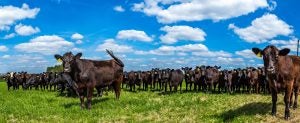Black Angus cattle is the most common breed in the United States, but why is it so popular?
It’s a go-to brand in steakhouses and groceries across the U.S. — Black Angus. And market data suggests that the name alone can fetch 10 to 15 percent higher prices than regular beef in the stores. Meanwhile on the feed lots, a new record of $1.51 million was hit in 2019 by Schaff Angus Valley for just one Black Angus bull, breaking the same outfit’s previous year’s record of $800,000.
In order to qualify as Certified Angus Beef, cattle have to have certified genetic qualities, including a minimum of 51 percent solid black hide coloring, hence the term “Black Angus,” as opposed to those which have a red hide. Genetically, there is no difference between black and red angus, but buyers show a distinct preference for the black. Producers and land-owners interested raising Angus cattle would do well to perform a little due diligence and determine whether the breed is indeed for them.
So what makes Black Angus cattle so preferable? Here are 7 interesting facts about one of America’s favorite breeds of beef cattle:
1. Details about the beef
Beef-eaters find preference in the Black Angus meat for a number of reasons related to genetics. To achieve the Certified Angus Beef brand by U.S. Department of Agriculture graders, beef must be a minimum of 51 percent black in hide, and possess a modest amount of higher-degree of marbling and medium to fine marbling texture. Cattle must also be “A” maturity, both lean and skeletal, and possess a 10- to 16-square-inch ribeye area. Hot carcass weight must be 1,050 pounds or less with superior muscling and practically free of capillary rupture. Beef must possess less than 1-inch fat thickness with no dark cutting characteristics and no neck hump exceeding two inches.
2. Data-driven results
Highly demanded Angus genetics are well documented with more than 20 million cattle records contained in the American Angus Association database, the largest of its kind. The AAA incorporates DNA technology with pedigree and performance data to create genomic-enhanced progeny differences, with these calculated and released to breeders weekly.
3. From across the pond
First brought to the Victoria, Kansas, in 1874 by George Grant, polled Angus bulls originated in Scotland in the Aberdeenshire area. The breed remains very successful in both Scotland and Ireland, both of which share similar weather and terrain to the U.S.
4. Big beef, big numbers
In 2019, the U.S. contained 304,577 head of registered Angus cattle, with the Montana leading the nation with 30,697. Nebraska’s 24,389 and the 20,706 of Texas make those states second and third.

5. Membership has benefits
The American Angus Association has five types of membership: Life, regular, junior, non-resident, and affiliate. Membership applications can be accessed online at www.angus.org. Benefits include access to Angus Herd Improvement Records, as well as MaternalPlus and GeneMax. Producers also have access to marketing tools in the consumer arena such as the Certified Angus Beef brand, with nearly 16,000 licensed partners and recognition in more than 40 nations.
6. Big and hearty
Most Black Angus cattle are medium to large, naturally polled with large muscle content. Average body weight for bulls is about 1,870 pounds, while cows weigh in at 1,200. Known for their heartiness, the Angus was bred to survive harsh Scottish winters with lots of snow. Overall the breed is known for a relatively easy temperament and fast growth. The darker hide pigmentation protects the breed against cancer eye and sun- and snow-burned udders, and the breed is known for easy calving.
7. Potential genetic disorders
The Angus breed does bring with it four potential recessive defects, which include arthrogryposis multiplex (AM), referred to as “curly calf” and affects lower mobility of joints; neuropathic hydrocephalus (NH), known as “water head,” which can cause a malformed skull; contractual arachnodactyly (CA) which is known as “fawn calf syndrome” and affects hip mobility; and dwarfism.
Whether a commercial operator or just looking for a few cows to graze, the Black Angus name goes a long way and does in fact command higher prices at the sale lot. And they do make for a mighty fine burger.
Curious about other breeds? Here are 7 facts about Hereford cattle, 6 facts about Japanese Wagyu cattle, as well as a list of the most popular cattle breeds in the U.S.
Brian Boyce is an award-winning writer living on a farm in west-central Indiana. You can see more of his work at www.boycegroupinc.com.



